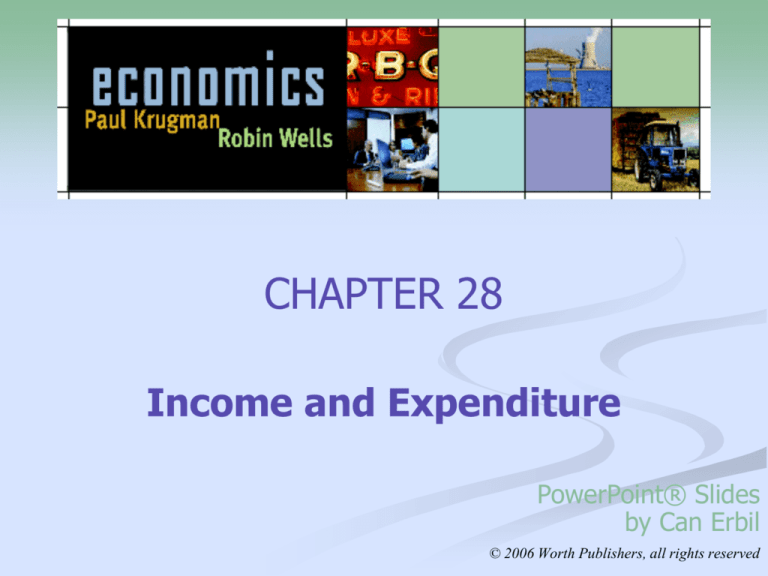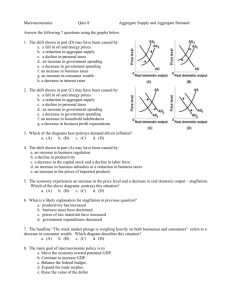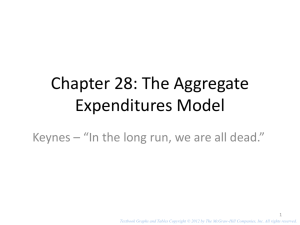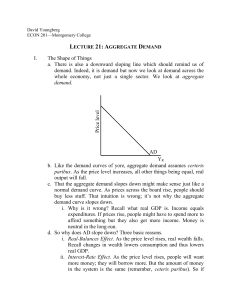
CHAPTER 28
Income and Expenditure
PowerPoint® Slides
by Can Erbil
© 2006 Worth Publishers, all rights reserved
What you will learn in this chapter:
The meaning of the consumption function, which shows
how disposable income affects consumer spending
How expected future income and aggregate wealth affect
consumer spending
The determinants of investment spending, and the distinction
between planned investment and unplanned inventory
investment
How the inventory adjustment process moves the economy to
a new equilibrium after a demand shock
Why investment spending is considered a leading indicator of
the future state of the economy
2
Consumer Spending
The consumption function is an equation showing how an
individual household’s consumer spending varies with the
household’s current disposable income.
3
Disposable Income and Consumer
Spending for American Households in 2003
4
The Consumption Function
5
Derivation of the Slope of the Consumption
Function
6
The Aggregate Consumption Function
7
An Upwards Shift of the Aggregate
Consumption Function
The aggregate consumption function
shifts in response to changes in
expected future income and changes in
aggregate wealth.
8
A Downwards Shift of the Aggregate
Consumption Function
9
Investment Spending
Planned investment spending is the investment spending that
businesses plan to undertake during a given period.
It depends negatively on:
interest rate
and
existing production capacity
and positively on:
expected future real GDP.
According to the accelerator principle, a higher rate of growth
in real GDP leads to higher planned investment spending.
10
Fluctuations in Investment
Spending and Consumer Spending
11
Inventories and Unplanned Investment
Spending
Inventories are stocks of goods held to satisfy future sales.
Inventory investment is the value of the change in total
inventories held in the economy during a given period.
Unplanned inventory investment occurs when actual sales
are more or less than businesses expected, leading to unplanned
changes in inventories.
Actual investment spending is the sum of planned investment
spending and unplanned inventory investment.
12
Behind Shifts of the Aggregate Demand Curve:
The Income-Expenditure Model
Assumptions underlying the multiplier process:
1.The aggregate price level is fixed.
2. The interest rate is fixed.
3. Taxes, transfers, and government purchases are all zero.
4. There is no foreign trade.
13
Planned Aggregate Spending and GDP
GDP = C + I
YD = GDP
C = A + MPC × YD
AEPlanned = C + IPlanned
Planned aggregate spending is the total amount of
planned spending in the economy.
14
Planned Aggregate Spending and GDP
15
Income-Expenditure Equilibrium
The
economy is in income–expenditure equilibrium when
GDP is equal to planned aggregate spending.
Income–expenditure
equilibrium GDP is the level of GDP at
which GDP equals planned aggregate spending.
16
Income-Expenditure Equilibrium
planned aggregate spending is larger than Y*,
unplanned inventory investment is negative; there is an
unanticipated reduction in inventories and firms increase
production.
When
planned aggregate spending is less than Y*, unplanned
inventory investment is positive; there is an unanticipated
increase in inventories and firms reduce production.
When
17
Income-Expenditure Equilibrium
The Keynesian cross is a diagram
that identifies income–expenditure
equilibrium as the point where a
planned aggregate spending line
crosses the 45-degree line.
18
The Multiplier Process and Inventory
Adjustment
19
The Multiplier Process and Inventory
Adjustment
20
The Paradox of Thrift
In
the Paradox of Thrift, households and producers cut their
spending in anticipation of future tough economic times.
These
actions depress the economy, leaving households and
producers worse off than if they hadn’t acted virtuously to prepare
for tough times.
It
is called a paradox because what’s usually “good” (saving
to provide for your family in hard times) is “bad” (because
it can make everyone worse off).
21
The Paradox of Thrift
22
The End of Chapter 11
coming attraction:
Chapter 12:
Fiscal Policy
23









